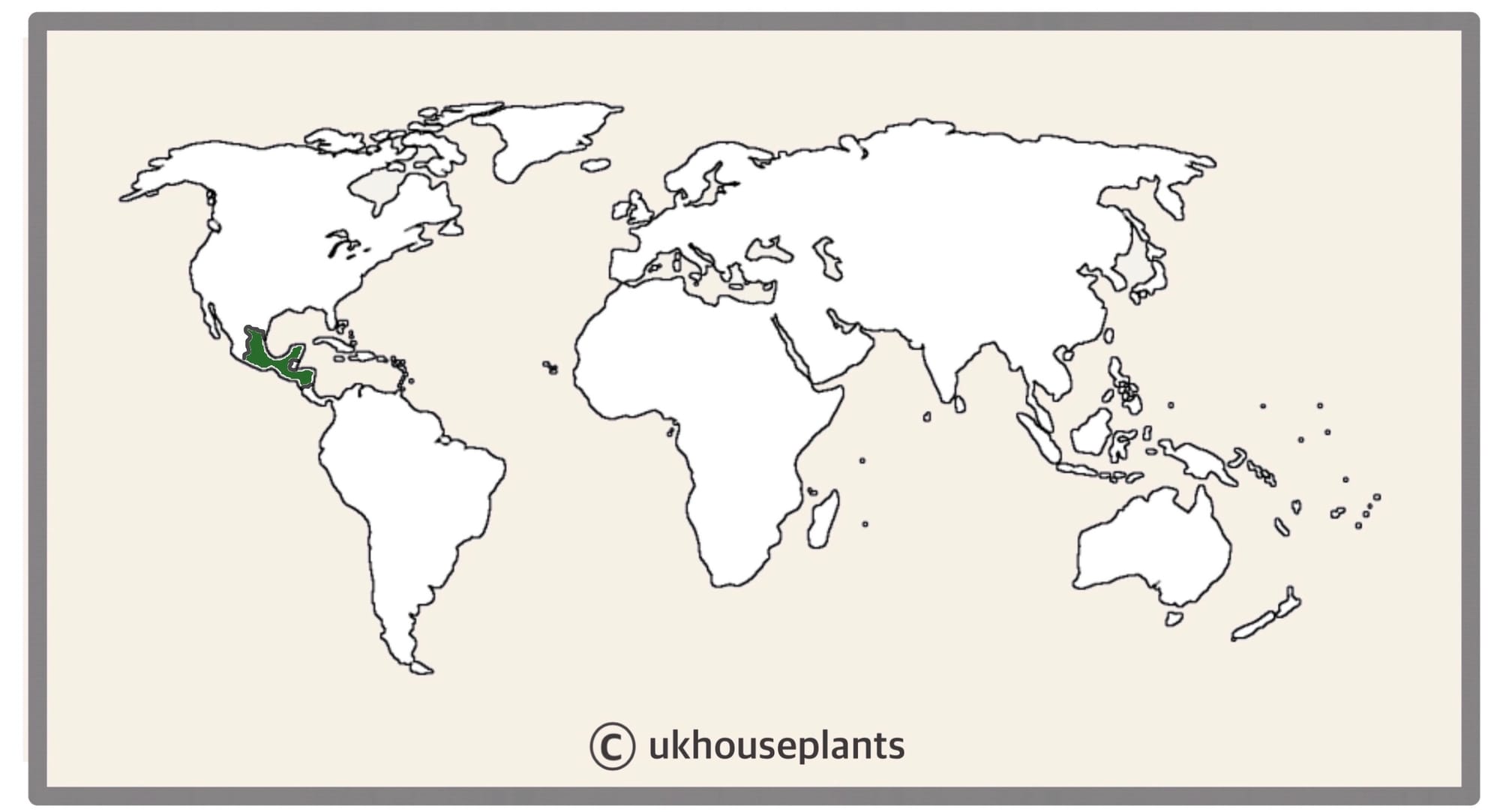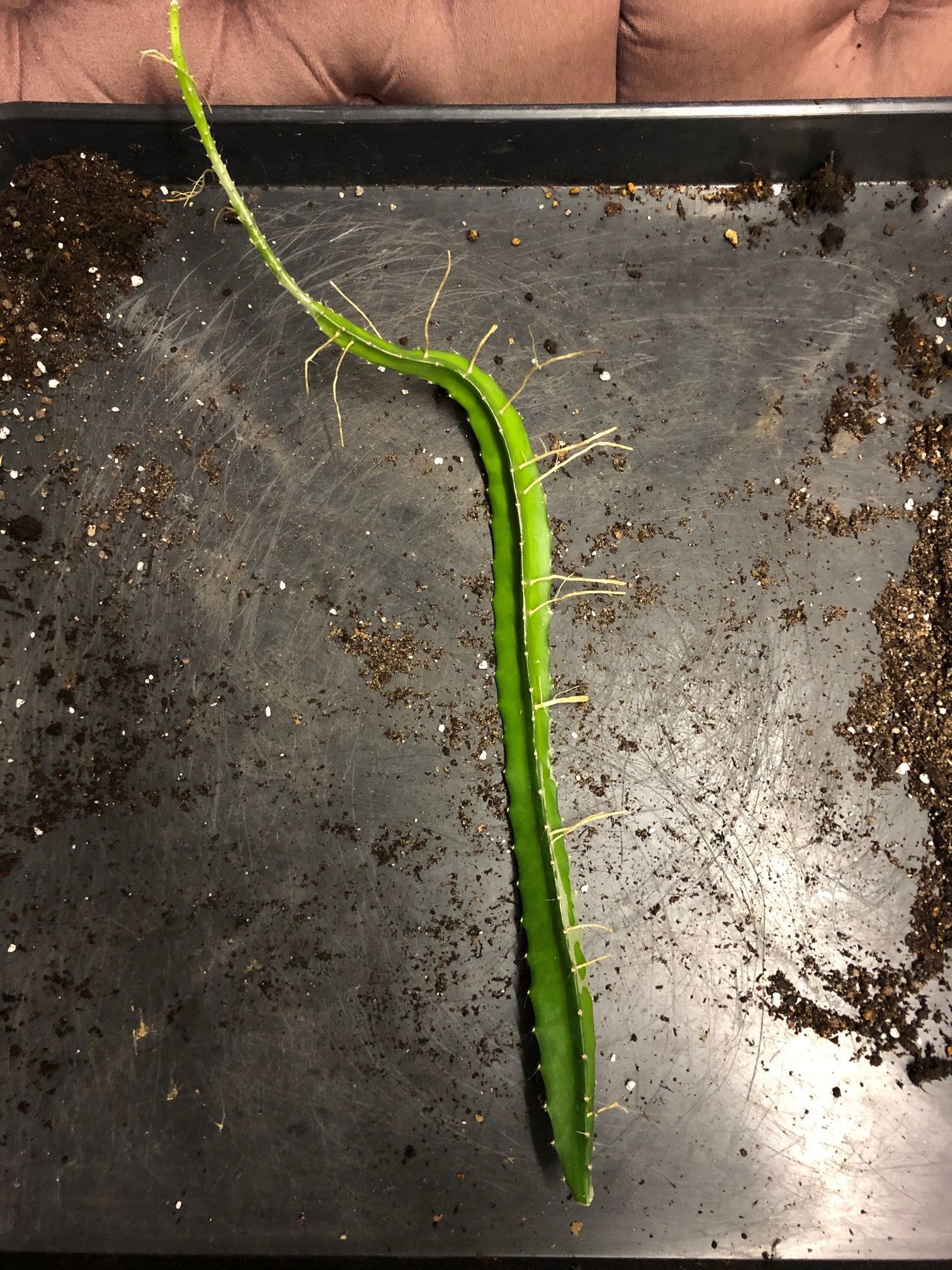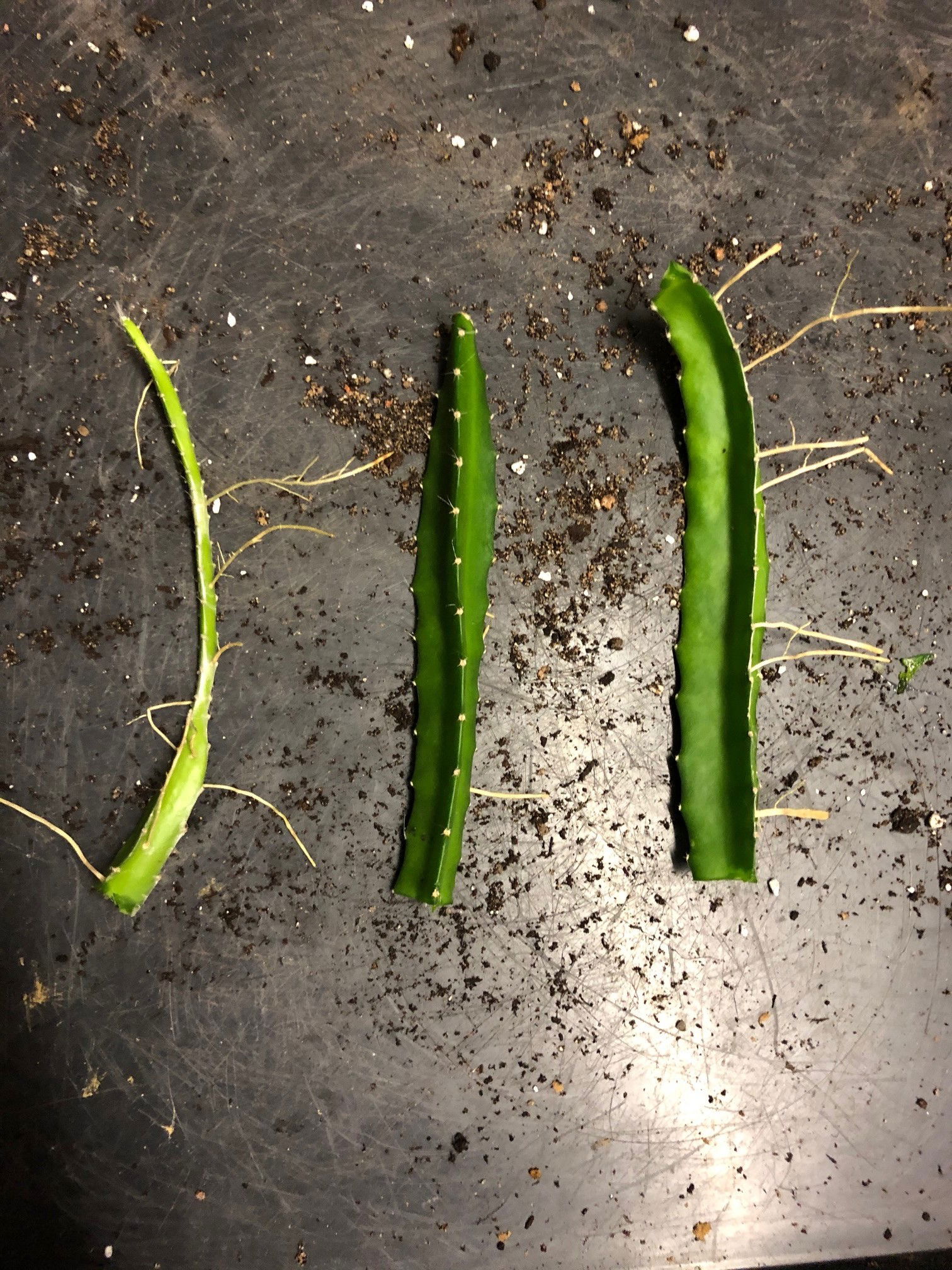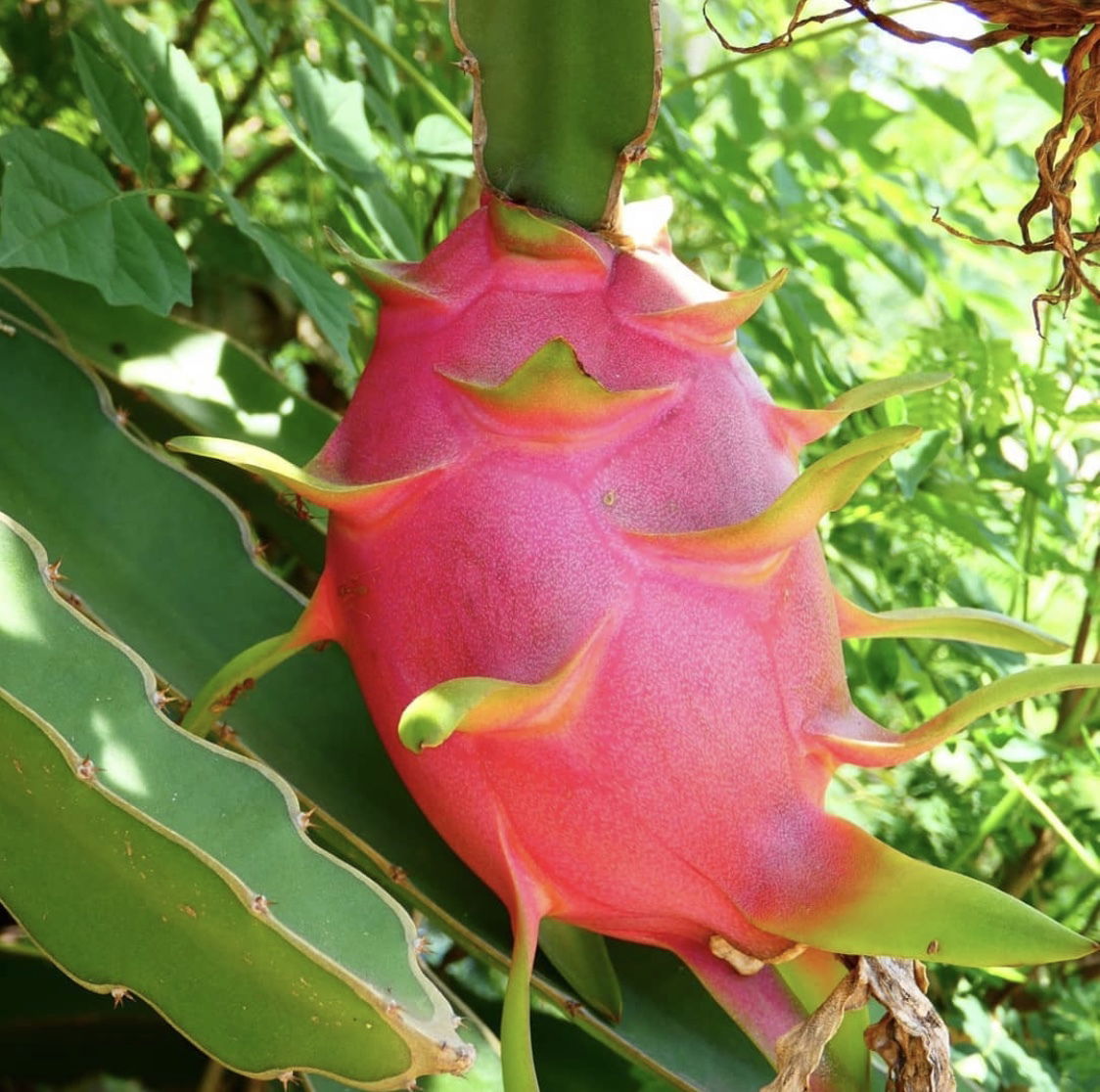
The fruit of Selenicereus undatus, formally known as Hylocereus undatus.
Contents
- Top Tips
- Location, Water, Humidity & Fertilisation
- Dormancy Care & Annual Flowers
- Common Issues
- Origins, Temperature, Propagation, Repotting & Toxicity.
Need the answer to a specific plant query? Book a 1-to-1 video call with Joe Bagley, the website's friendly author, to overcome and address your niggling problem! Available on iMessage, WhatsApp, Facebook Messenger & more.
Top Tips & Info
- Care Difficulty - Easy
- Provide a bright, sun-filled location to thicken the phylloclades (modified leaves that function like stems over-time), avoiding shady areas altogether.
- Allow the soil's majority to dry out in between waters, reducing this to 'drenches between droughts' in the cooler months. It's always better to under-water a Dragonfruit than over-do it, purely based on its drought tolerance and susceptibility to root rot.
- Although average room humidity is acceptable, introduce a humidity/pebble tray to keep the surrounding moisture high during the winter. The use of artificial humidity isn't needed in the spring, summer & autumn months, while the heaters are off.
- Fertilise using a 'Houseplant' or 'Cactus' labelled feed every four waters in the spring and summer, reducing this to every six in the colder months.
- Regularly check for pests, most notably Mealybugs and Scale that'll infest the cubbyholes of the foliage. Click on the appropriate links to learn more about addressing this issue.
- Keep the ambient temperature above 10℃ (50℉) throughout the year, especially if placed outdoors in the summer.
- Once matured, which can take several years to achieve, rosette/shaped flowers will develop in the summer, lasting only a few days once opened. The chance of a bloom is heightened if the specimen undergoes a successful dormancy period in the previous winter. Scroll down to 'Dormancy Care & Annual Flowers' for more information.
- During the spring, repot every three years using a 'Cactus & Succulent' potting mix; this is a perfect time to take stem cuttings.
Location & Light - 🔸🔸
Provide a bright location with either a few hours of morning or evening sunlight. Not only will the natural light keep the soil from becoming soggy, but it will also sweeten and thicken the phylloclades' durability. A setting where a newspaper cannot be read must be turned away as the chance of root rot (especially over winter) is heightened.
A location within a metre of a north, east, south or west-facing window, or below a skylight window is the optimum area. For established specimens that are liable to bloom, place in a cool conservatory with nighttime temperatures around 12°C (54°F) during the autumn and winter months. This will help ease them into the dormancy period, which is critical for the following bloom in the summer.
Water - 🔸🔸
Because of the water-retentive phylloclades, Dragonfruit can withstand several weeks without water. Although it isn't ideal to regularly test this ability, it's good to know if you're away for a short while. Allow almost all of the soil to dry out in between irrigations, reducing this further in the autumn and winter. This will not only reinforce its dormancy period, but it'll also downplay the risk of root rot - common during the longer nights and cooler days. Under-watering symptoms include little to no new growth, a much-needed transplant and drying leaves. Over-watering symptoms, on the other hand, include yellowing leaves that soon drop off, little to no growth and root rot. These are common with too much soil moisture, an improper soil medium or deep shade. As with most houseplants, under-watering is far better than over-doing it, as each species has evolved to optimise water retention in case of drought. If the bottom of the stem becomes brown and mushy, the chances are root rot has occurred; take stem cuttings on non-affected growth by following the tips mentioned in 'Propagation'.
Humidity - 🔸🔸🔸
Average room humidity is enough to occupy a Dragonfruit; however, as the heaters begin to be switched back on, introduce a pebble tray to counteract the risk of dry air.
Fertilisation - 🔸🔸
Feed once every four waters using a 'Houseplant' or 'Cactus' labelled fertiliser, reducing this to every sixth water in the autumn and winter.
Whilst the plant is budding or in bloom, swap for a potassium-based feed, for example, 'Tomato' food, to prolong the flowering process. Never directly apply an RTU (ready to use) feed without a pre-water first, as this will result in root burn and yellowed leaves.
Dormancy Care & Annual Flowers
As Dragonfruit plants mature, they'll begin to produce several flowers per year from late spring to early summer. Although domestically grown specimens will find it challenging to bloom, those kept in partial sun outdoors or in an orangery are more likely to become sexualised.
The following steps should be performed from early autumn until the following production of fruits, twelve months later. Keep the roots pot-bound to add further stress onto the specimen, which in turn will significantly heighten the chance of flowering. Blooms will generally appear from late spring until early summer but may occur later on in the season.
Sunlight
Be sure to provide a bright location with several hours of direct sunlight a day. Although the winter rays won't necessarily hurt the plant, be careful not to fall in the trap of sun-scorch and severe dehydration if yours hasn't been exposed to the sunlight before.
Avoid the use of artificial lighting at night or locations that boast temperatures higher than 18℃ (64℉).
Hydration
Reduce watering so that the soil becomes almost dry for a week, for the prevention of root rot and to replicate its dormancy period.
Occasional Feeds
One or two feeds using 'Cactus & Succulent' Fertiliser is all that is needed for supplementation from autumn till early spring, as too nutritious soil will reduce the chance of buds. From mid-spring onwards, be sure to use a potassium-based feed to stimulate the development of buds - tomato feeds are an excellent choice.
Reduce Everything
This one is a reminder to reduce everything - especially the temperature.
Temperature
Reduce the temperature down by around 5℃ compared to the summertime or place in a room that's between 12º - 15℃ (54º - 59℉). The drop in temperature should ideally last until the start of spring when the natural temperatures increase. You'll be at a significant disadvantage if the ambient temperature is kept constant throughout the year, as Dragonfruit will only respond in locations that have daily fluctuations of around 5℃. Never exceed the minimum temperature as it may lead to plant death or blackened foliage at a bare minimum.
| Time of Year | Care Requirements |
| January & February | Resting/Dormancy Period. Reduce irrigations and fertilisation. |
| March | End of Resting/Dormancy Period. Increase waters and feed using a nitrogen-based fertiliser at monthly intervals. |
| April | Pre-Flowering Period. Use a potassium-based feed fortnightly during this period. Water once the top their of the soil dries out. |
| May & June | Flowering Period. Maintain moist soil and fortnightly potassium-based feeds. |
| July | End of the Flowering Period. Gradually decrease both water and fertiliser intake in the soil. Remove spent flowers as they wilt. |
| August & September | Water once the majority of the soil has dried out. Supplement using houseplant feed or a general plant fertiliser, at monthly intervals. |
| October - December | Resting/Dormancy Period. Reduce irrigations and fertilisation. |
An Absence of Flowers
If a matured Dragonfruit hasn't flowered during the spring or summer, it's most likely due to incorrect care and its environment throughout the year. During the winter, reduce irrigations so that the soil almost dries out, along with reducing the temperature a few degrees. Provide an area that has at least twelve hours of complete darkness, with an absence of artificial light during the night. The buds may start to drop off if it endures persistent droughts or has been relocated in another room. The table above shows a necessary timetable in which you can follow to increase the chance of flowers during the spring significantly.
Common Issues with Dragonfruit
Root rot is a big issue with symptoms including yellow lower leaves, stunted or softened growth - often accompanied by stem collapse. Take the plant out of the pot and inspect its root systems. Yellow roots translate to good health; however, brown and mushy sections with soggy soil is the result of over-watering. More information about addressing root rot can be found on this link.
A brown, rotten base is also another byproduct of over-watering. If the majority of the trunk has rotted over, stem cuttings must be taken to save the remaining section of the plant. Scroll down to ‘Propagation’ for more information!
For smaller compact specimens, typically in a 5cm pot (2 inches), yellowing central leaves or a naked base are products of excess moisture being allowed to sit on the foliage. Although watering from the top is acceptable, it's recommended to use the bottom-up method to reduce the chance of rotten foliage. For those that have a bare head over the soil, improve growing contains by using this method and increasing light levels. Promote a bushier appearance by taking vine cuttings and placing them halfway down into the soil once the stems reach over 5cm. Immediately remove yellowed or rotten debris as this will harbour both bacterial and fungal diseases that can both spread across to other sections of the plant.
Blisters appearing on your Dragonfruit Plant (Selenicereus undatus) is most likely due to over-watering. If this has occurred with yours, improve your watering regime by allow ALL of its soil to dry in between drinks. You could also try relocating the plant into a brighter windowsill to dry the soil out quicker, thus reducing the risk the soil becoming wet and stagnant. The blisters should eventually harden over so you don't need to prune it off.
Failed leaf or stem cuttings are a common issue among amateur gardeners, with damaged wounds or too small vines being the usual culprits. Although propagating all tropical cacti is relatively easy, people still find it hard to ace. Not only will the size of the vine dictate its success, damaging the leaves or vine can also hurt the chances of rooting. For more information about how to take vines, scroll to the 'Propagation' section of this article.
Too much sunlight will cause a red tinge to the foliage. Although Dragonfruit are best grown in locations offering several hours of sun, prolonged periods on non-acclimated specimens will lead to sun-scorch. If yours is a newly-purchased plant, build its tolerance to the sharp rays by increasing the amount of receivable light per week by an hour.
A lack of flowers is caused by immaturity or an insufficient dormancy period served in the winter months. Specimens will only flower once they reach maturity - which can take in the region of three to eight years from a leaf cutting. Also, locations that offer near-similar temperatures all year round won't allow the plant to go dormant, resulting in poor spring growth. To achieve bud development, situate in a location that offers nighttime temperatures of around 12°C (54°F) with fewer waters. The combination of both cooler temperatures and dry soil during the colder months will help season the plant, thus leading to a better chance of flowers in the future.
Always use lukewarm water, and if you choose to use tap water, allow it to stand for at least 24hrs before application. Tropical cacti tend to be quite sensitive to temperature change, so pouring cold tap water immediately into the pot will not only ironise your roots but could even cause yellow edges, sudden flower loss and stunted growth.
Origins
The original name, Hylocereus, is an epiphytic or lithophytic genus originating from Central America. It was first described by Britton & Rose in the early 20th century, using the Greek and Latin words hyle, meaning wood, and cereus, referring to its 'waxy' nature. The current name of the species, Selenicereus undatus, also originates from Latin, with the first section translating to 'moon' (Selḗnē). The species epithet, undatus, can be translated to 'wavy edges' that is in reference to the rib-like structure of the stem.
 The Distribution of Selenicereus undatus.
The Distribution of Selenicereus undatus.
Temperature
10°C - 26°C (50° - 78°F)
H1b (Hardiness Zone 12) - Can be grown outdoors during the summer in a sheltered location with temperatures above 12℃ (54℉), but is fine to remain indoors, too. If you decide to bring this plant outdoors, don't allow it to endure any direct sunlight as it may result in sun-scorch and dehydration. Regularly keep an eye out for pests, especially when re-introducing it back indoors.
Spread
Up to 3m in height and 1m in width, with maturity taking up to eight years. If you have images of any tropical cacti that are over twenty years old, be sure to send an image via the 'Contact Me' section of this website!
Pruning & Maintenance
Remove yellow or dying leaves, and plant debris to encourage better-growing conditions. While pruning, always use clean utensils or shears to reduce the chance of bacterial and fungal diseases. Never cut through yellowed tissue as this may cause further damage in the likes of diseases or bacterial infections. Remember to make clean incisions as too-damaged wounds may shock the plant, causing weakened growth and a decline in health.
Vine cuttings can be taken to halve the vine-length of the specimen, as well as doubling your stock.
Propagation
Via Seed or Phylloclade (modified leaves).
Soil Propagation of Leaf & Stem Cuttings
- Choose which leaves to use - the ideal candidates are those that show no sign of damage, pests or diseases, and have small wired roots already-attached. Cuttings that don't have any roots will still survive, but it may take a little longer for its propagation.

- Delicately prune the whole leaf off from the plant, and cut it into several sections sideways; if you're stuck on which way to propagate the leaves, look at the image below!

- Prepare the pot and soil. Choosing a free-draining potting mix, for example, 'Cactus & Succulent' compost provides a nice balance of moisture-retention and drainage. Of course, most soils are acceptable (Houseplant or Multi-purpose compost), but try to add some extra ingredients like grit, sand and perlite to help loosen it up. If you have any shallow and wide pots, for example, a Bonsai pot, this is the time to use it. Propagating tropical cacti cuttings won't require deep soil, so try and avoid containers that are too large. Terracotta and plastic pots are both acceptable in this instance.
- Place the cuttings ON TOP of the moist soil. Allowing both the plant and it's wound to callus over (dry up) will kick-start the rooting process, along with the prevention of rot. Keep the cuttings on top of moist soil for a week, misting the soil and foliage on opposite days.
- Provide a bright, indirect location with temperatures above 18°C (64°F) throughout this period.
- ThePlace the cuttings into the soil, submerging the bottom third. Be sure you don't set it too deeply into the soil, as this may lead to 'Blackleg' (the rotting of its base).
- Do NOT pat down the surrounding soil to aid support. The ideal soil conditions need to be fluffy and oxygenated, so compacting the soil will result in the suffocation of roots that'll lead to root rot. Tap the pot's side to consolidate (not compact) the soil. If support is needed, use a small stick or cane, but be sure NOT to condense it.
- Aftercare - Maintain evenly moist compost, allowing the top half to dry out in between waters. The ideal location would be in a warm, humid room within a few metres of a window, but out of direct light. After another month or two of being in the soil, treat it like a normal houseplant.
Flowers & Fruits
Dragonfruit plants will bud mostly in the summer with rosette-shaped flowers, sporting either red, yellow, pink or white appearances. Each flower will take several weeks to develop, lasting only a few days once opened - most hybrids or species will produce a sweet-smelling fragrance that'll be most prominent at night. Be sure to take photos of your specimen in bloom, as the flowers will only last a few days!
If pollination is successful, the flowers' ovules will develop into edible fruits. For those who aren't aware, Dragonfruits, or better known in Asia as Pitahaya (Pitaya), can boast a whole range of health benefits, including Vitamin B2 & C, Iron and Magnesium. The outer shell and central pulp (flesh) are also BEAUTIFUL and delicious - have a look at the images below!
 Copyright: @brusorioart
Copyright: @brusorioart
 Copyright: @brusorioart
Copyright: @brusorioart
Repotting
Repot every three years during the summer into a slightly bigger pot using 'Cactus & Succulent' labelled compost. This is an excellent time to check the roots' condition, as well as the propagation of vine cuttings. As all tropical cacti are prone to root rot, have a look around the bottom half of the root ball for any brown or broken down roots. If this is the case, remove the affected areas with clean utensils and ease off with the irritations. Click on this link to learn about how to perform the perfect transplant!
Book a 1-to-1 video call with Joe Bagley if you'd like a personal guide to repotting your houseplant. This will include recommending the right branded-compost and pot size, followed by a live video call whilst you transplant the specimen for step-by-step guidance and answer any further questions!
Pests & Diseases
Keep an eye out for scale, spider mites, mealybugs & vine weevils. Typical diseases associated with Dragonfruit are root or leaf rot, leaf-spot disease, botrytis petal blight & powdery mildew. For more information on how to address any of these issues, click on this link. Identifying Common Houseplant Diseases
Toxicity
Dragonfruit are classified as non-poisonous. If large quantities of the plant are eaten, vomiting, nausea and a loss of appetite could occur.
Retail Locations
Online Stores.
Book a 1-to-1 Call with Joe Bagley
If you need further advice with your houseplants, book an advice call with ukhouseplants' friendly and expert writer today! This can be done via a video or audio call on most apps, including Facebook, FaceTime & Skype. A ten-minute call costs £5.99 (US$7), or £15.99 for thirty minutes. You can ask multiple questions, including queries on plants, pests, terrariums, repotting advice and anything in between. Please consider supporting this service to keep ukhouseplants thriving!